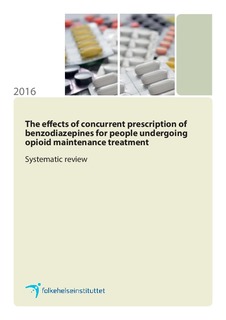The effects of concurrent prescription of benzodiazepines for people undergoing opioid maintenance treatment: A systematic review
Research report
Permanent lenke
http://hdl.handle.net/11250/2436233Utgivelsesdato
2016Metadata
Vis full innførselSamlinger
- Artikler [5068]
- Publikasjoner fra CRIStin FHI [7544]
Sammendrag
Background
In Opioid Maintenance Treatment patients receive long acting opioids as a substitute for heroin and other common illegally used opioids. People with opioid dependence are likely to experience elevated levels of anxiety and sleep disturbance. Therefore, benzodiazepines are often prescribed for these patients to alleviate such problems. Meanwhile, benzodiazepines are readily available on the illicit street market and are in high risk to be misused. Several studies find that concurrent prescription of benzodiazepines during opioid maintenance treatment is associated with more drug abuse and dependence. Prolonged use of benzodiazepines may result in anxiety and mental health problems, and increased risk of personal injury. However, the evidence is mostly descriptive and does not distinguish between prescribed versus illicitly procured benzodiazepines.
Objective
The purpose of this systematic review is to assess the effects of concurrent benzodiazepines prescription among people who receive opioid maintenance treatment (i.e. methadone, buprenorphine or buprenorphine combined with naloxone).
Method
We first searched for systematic reviews that could answer our research question in the following databases: Epistemonikos, Cochrane Library (CDSR, DARE, HTA), MEDLINE (Ovid), PubMed [sb] and Embase (Ovid). Thereafter, we searched for primary studies to conduct a systematic review to summarize the available evidence.
Randomised and non-randomised controlled trials, controlled before-and-after studies and interrupted time series were included as relevant study designs. The target population was people 18 years or older who received substitution treatment with methadone, buprenorphine or buprenorphine combined with naloxone for opioid dependence. Relevant intervention was prescription of benzodiazepines as compared with no prescription of benzodiazepines. The outcomes of interest were retention in treatment, patients’ satisfaction, opioid use (self report or biological test), other substance use (self report or biological test), extent of anxiety and depression, sleep disorders, mortality, side effects (overdose, injury and use of hospital emergency) and criminal offences.
We carried out a systematic search for literature, with no limit of publication time or language, in Cochrane Central Register of Controlled Trials (CENTRAL), MEDLINE (Ovid), PubMed [sb], Embase (Ovid), CINAHL (EBSCO) and PsycINFO. Three authors evaluated the references based on the title and abstract, in pairs independently of each other (Kristoffer Yunpeng Ding evaluated all, Annhild Mosdøl and Laila Hov half each). Potentially relevant references were read in full-text (Kristoffer Yunpeng Ding evaluated all, Annhild Mosdøl and Laila Hov half each). We planned to assess the risk of bias, synthesise the data if possible and use the GRADE method (Grading of Recommendation Assessment, Development and Evaluation) to assess our confidence in the estimated effects.
Results
The literature search for systematic reviews identified 998 titles and abstracts. No systematic reviews were relevant for this topic after screening.
The search for primary studies identified 3696 references. We considered eight references as potentially relevant and read them in full text. However, none of these references met our inclusion criteria.
Discussion
We did not find any relevant systematic reviews, clinical trials or controlled studies meeting our inclusion criteria.
Experimental studies with controlled use of benzodiazepines are needed to evaluate the effects and consequences of benzodiazepines prescription during opioid maintenance treatment. We suggest the following outcomes: drug retention rates and abuse; patient satisfaction; mental health; sleep disorders; side effects and criminal behaviours.
Conclusion
We found no controlled studies focusing on the effects and consequences of concurrent benzodiazepines prescription during opioid maintenance treatment.
